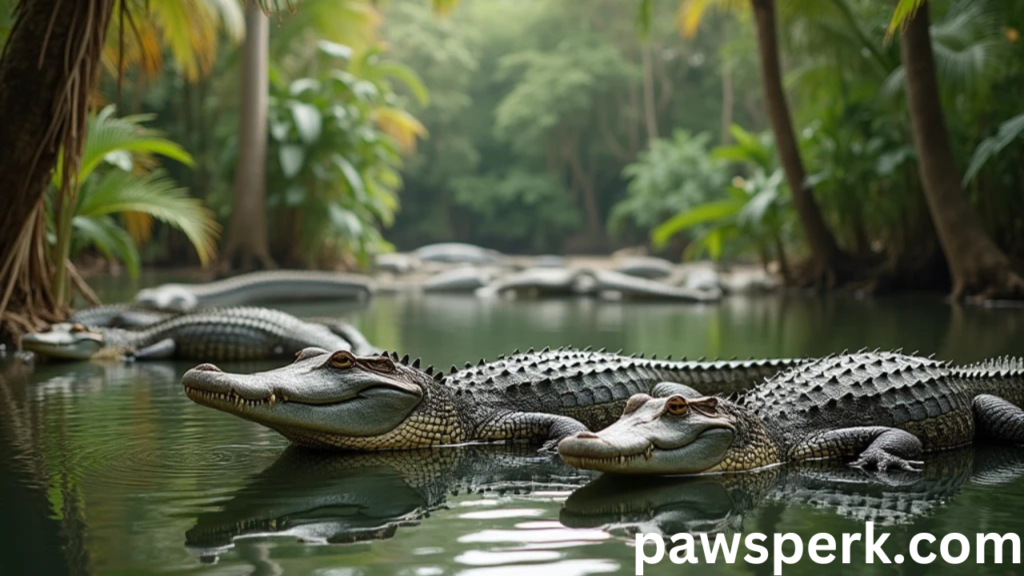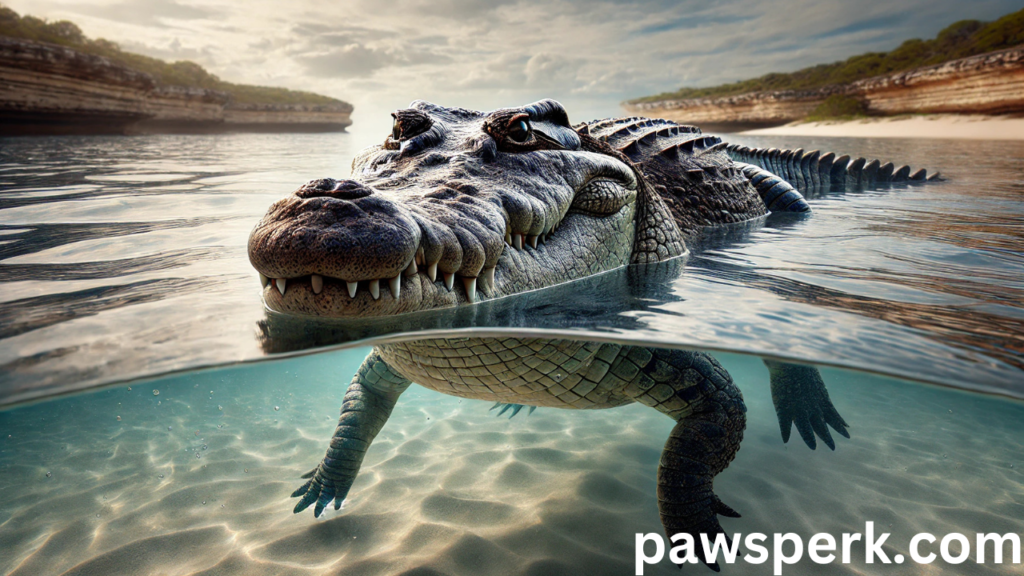The Australian saltwater crocodile possesses a tough, scaly armor that shields it from harsh weather and potential predators. Its rugged skin provides essential protection, ensuring survival in challenging environments. With a coloration that ranges from olive green to brown, it blends seamlessly into its natural habitats, such as mangrove swamps, estuaries, and coastal regions. This natural camouflage allows it to remain undetected, making it an effective ambush predator and reinforcing its role as a top predator in the ecosystem.
Physical Characteristics
Because of their size, people are familiar with saltwater crocodiles. Male adults normally reach a length of 4 to 5 meters (13 to 16 feet), while some extraordinary individuals may weigh over 1,000 kilograms (2,200 pounds) and reach a height of 7 meters (23 feet). Their strong bodies are adapted for aquatic existence and let them swim with remarkable agility. They have a muscular tail, webbed feet, and a streamlined body. They may remain mostly submerged and still see and breathe because their eyes and nostrils are located on top of their skulls.
Saltwater crocodiles are equipped with a tough, scaly armor that provides essential protection against harsh weather conditions and potential predators. Their thick, rugged skin acts as a natural defense, ensuring their survival in diverse and often challenging environments.
In addition to their protective armor, these apex predators possess remarkable camouflage abilities. Their coloration, which ranges from olive green to brown, allows them to seamlessly blend into their natural habitats, including mangrove swamps, estuaries, and coastal regions. This natural disguise helps them remain undetected by both prey and threats, enhancing their effectiveness as ambush hunters and reinforcing their dominance in the ecosystem.
You may also like: Equine Bute: A Comprehensive Guide to Phenylbutazone
Habitat and Distribution
Northern Australia and Southeast Asia are home to saltwater crocodiles. They live along Australia’s coast from Rockhampton in Queensland to Broome in Western Australia, including a sizable population in the Northern Territory. In addition to freshwater rivers, these versatile reptiles can also survive in brackish water and even open ocean habitats. They may travel great distances in pursuit of food or appropriate nesting locations because of their tolerance for seawater.
Diet and Hunting Behavior
Fish, birds, mammals, and even larger prey like buffalo and wild boar are all part of the varied diet of saltwater crocodiles, who are apex predators. Their ability to hold their breath for up to eight hours while waiting for the ideal opportunity to ambush unwary prey is a hallmark of their stealthy hunting style. Once they strike, their powerful jaws—capable of exerting one of the strongest bites in the animal kingdom—secure their catch before performing a death roll to subdue it.
Juvenile crocodiles primarily consume smaller fish and insects until they grow large enough to tackle bigger prey. This adaptability in diet ensures that they can thrive in various environments throughout their life stages.
Behavioral Traits
Saltwater crocodiles exhibit fascinating behaviors shaped by millions of years of evolution. While they are primarily solitary, they sometimes gather in groups during cooler months, floating in the water or basking on riverbanks. During mating season, males display dominance, but social interactions remain limited.
These reptiles also possess remarkable intelligence, often underestimated. Studies show that saltwater crocodiles can quickly learn complex tasks with minimal conditioning. They also use vocalizations and body language to communicate, especially during mating rituals, highlighting their advanced behavioral adaptations.

Conservation Status
Saltwater crocodiles have faced significant threats from hunting and habitat loss due to human activity. However, conservation efforts have successfully increased their population across Australia. Effective habitat protection and regulated hunting practices have led to their classification as “Least Concern” on the IUCN Red List.
Despite this progress, saltwater crocodiles remain at risk in certain regions, particularly in Queensland, due to frequent human encounters. Communities living near crocodile habitats must understand their behavior and ecology to minimize conflicts and promote safe coexistence.encourage cohabitation.
Human Interaction
Saltwater crocodiles and humans share a complex relationship. While attacks on humans are rare, they occur when people unknowingly enter crocodile habitats. Most incidents happen during swimming or fishing, highlighting the importance of awareness and caution near crocodile-inhabited waters. Understanding crocodile behavior plays a key role in preventing such encounters.
Saltwater crocodiles also hold deep cultural significance. Indigenous Australian communities revere them as symbols of strength and resilience. Conservation efforts now integrate traditional ecological knowledge with modern strategies to ensure these remarkable reptiles thrive alongside human populations.
Conclusion
The Australian saltwater crocodile (Crocodylus porosus) is more than just a top predator; it is a keystone species that plays a crucial role in maintaining ecological balance. As the largest living reptile, it helps regulate populations of prey species, preventing overgrazing and ensuring the health of wetland ecosystems. Without these apex predators, the delicate balance of their habitats could be disrupted, leading to unforeseen environmental consequences.
Beyond its ecological significance, the saltwater crocodile has a deep-rooted connection with human civilization. Indigenous Australian cultures have revered these reptiles for thousands of years, viewing them as symbols of strength, resilience, and survival. Stories, artwork, and traditional knowledge passed down through generations highlight their importance in Aboriginal heritage. Today, conservationists work to integrate this traditional wisdom with modern scientific approaches to ensure effective protection strategies.


